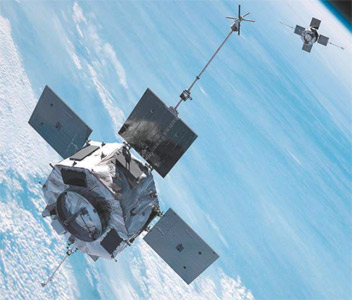How's my blogging? Leave some feedback, I get better at this, you get a more interesting read! Or at least fewer spelling mistakes.
Edit: Here's some additional material [0], from the press briefing for the RBSP mission.
It’s tempting to think that the space between the Earth and the Moon is fairly empty. But a complete map of cis-lunar space would actually be pretty complicated. There are the satellites in low Earth orbit, medium Earth orbit, high orbit, and polar orbits. There's the magnetic field of Earth [1] protecting us, the lucrative geostationary satellite ring [2], the various small temporary moons [3] and quasimoons [4] that come and go with time, near earth asteroids that zip past on a regular basis, the L4 and L5 Lagrange points [5], the geocorona [6]…. It's busy up there - a realm in it's own right.
And it has badlands: The Van Allen radiation belts [7].
Image above: A visualisation of the inner and outer Van Allen belts, countless high speed particles caged in the magnetic field of Earth. Enough radiation to kill just about anything, hanging over your head right now. Image courtesy of NASA.
The belts are made of high energy charged particles, from the solar wind [8], funnelled into two huge doughnuts by the magnetic field of Earth:
The inner belt stretches from sixty miles above the surface (touching the atmosphere over the South Atlantic Anomaly [9]) out to six thousand miles. It's composed of high speed electrons, protons, and smaller numbers of other particle like alpha particles [10] and oxygen ions.
The outer belt stretches from eight thousand four hundred miles out to thirty six thousand, and is mainly made of electrons. When a solar storm [11] hits it the outer belt inflates with protons from the Sun, that seep down into the inner belt over a day or so. It's a bit like filling a ballot with air, then slowly releasing it, except the balloon is a huge magnetic field, the air is high speed DNA smashing protons [12]... OK, it's not very like filling a balloon with air. But I did only say a bit....
Video above: The Van Allen belts, shown here in cross section, twitching like crazy as a solar storm runs over and through them. The forces at work here are titanic. Yet I can't get past how much it looks like a pair of huge ears flapping about..... Video courtesy of NASA/Goddard.
These belts surround Earth like reefs: They can damage or disable [13] spacecraft that pass through them when they're active, and many spacecraft do. But they are also an important part of the interplay between Earth, solar storms, and interplanetary space.
It's worth knowing about them for other reasons to: Most of the universe is made of electrically charged particles [14] (called plasma), funnelled by magnetic fields, just like the belts. These plasmas can even form strange crystals [15], and it's been proposed they might hold life like patterns [16].
Video above: A quick low down on the radiation belts around Earth, and the RBSP twin space craft being sent to explore them. Although it isn't really a low down, these are spaceships, so it's a high up.... ....I'll get my coat. Video courtesy of NASA/Goddard.
Our radiation belts belts are a huge natural plasma lab, and NASA is taking a closer look: On August the twenty third, the two octahedral Radiation Belt Storm Probes [17] are being sent into these badlands, to study them up close. Other missions have done this, but this is the first to use two probes to get a comprehensive real time view of how the belts act, and using one of the best suites of sensors ever flown to them.
Image above: One of the RBSP spaceships. A made up image, I assume, unless NASA is employing Dr Who as a photographer now. Image courtesy of NASA.
The RBSP mission will answer questions like: What mechanism accelerates the particles in the belts to such high speeds? How to they react to coronal mass ejections, and why? What role do they play in geomagnetic storms and aurora? We have some ideas already, but the RBSP mission will give us a much, much, clearer picture.
And when you're sharing your part of the solar system with two massive, unpredictable, belts of ionising radiation [18] - and you are - a clear picture is a good idea...
Lastly, just because, here's a stunning video of the Earth from space:
Video above: The Earth, as seen from the International Space Station. Just because it's beautiful, and because this is what space missions, like RBSP, are helping us to understand and protect. Video courtesy of NASA.
List of links:
[0]http://www.nasa.gov/mission_pages/rbsp/multimedia/20120809_L-14_briefing_materials.html
[1]http://csep10.phys.utk.edu/astr161/lect/earth/magnetic.html
[2]http://www.cato.org/pubs/regulation/regv8n4/v8n4-3.pdf
[3]http://www.scientificamerican.com/podcast/episode.cfm?id=earth-usually-has-second-tiny-tempo-11-12-27
[4]http://www.astronomy.com/en/News-Observing/News/2004/05/A%20new%20moon%20for%20Earth.aspx
[5]http://www.esa.int/esaSC/SEMM17XJD1E_index_0.html
[6]http://en.wikipedia.org/wiki/Geocorona
[7]http://imagine.gsfc.nasa.gov/docs/ask_astro/answers/970228a.html
[8]http://solarscience.msfc.nasa.gov/SolarWind.shtml
[9]http://www.astronomycafe.net/qadir/q525.html
[10]http://en.wikipedia.org/wiki/Alpha_particle
[11]http://helios.gsfc.nasa.gov/cme.html
[12]http://www.ncbi.nlm.nih.gov/pubmed/12600243
[13]http://www.nasa.gov/vision/universe/solarsystem/killer_electrons.html
[14]http://www.ucl.ac.uk/mssl/space-plasma-physics/plasma-science
[15]http://www.mpe.mpg.de/%7Emkr/pubs/Thoma_Kretschmer-AJP.pdf
[16]http://www.space.com/4219-hot-gas-space-mimics-life.html
[17]http://www.nasa.gov/mission_pages/rbsp/main/index.html
[18]http://en.wikipedia.org/wiki/Ionizing_radiation


No comments:
Post a Comment